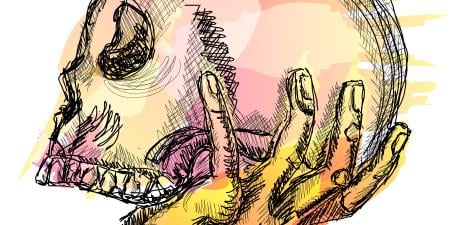At this moment, medicine and health care in America are at a crossroads. In this time of transition, individual physicians and physician groups, like the American Medical Association and various state and specialty medical societies, are voicing their perspectives about how best to improve our system and bring health to our patients. As the scope of this conversation grows, it includes social determinants of health like socioeconomic status, race or ethnicity, and sexual orientation. Differences in how people are treated by their society can lead to significant health disparities. We physicians and physicians-in-training need to take a hard look at what our real obligation is to our society.
Do physicians, individually and together in organized medicine, have a responsibility to act to improve the health of those we serve? And, if so, how far does that responsibility extend? One bit of insight comes from the Hippocratic Oath many physicians have taken throughout the centuries, which includes the following lines:
I will prevent disease whenever I can, for prevention is preferable to cure; I will remember that I remain a member of society, with special obligations to all my fellow human beings, those sound of mind and body as well as the infirm [1].
The oath is explicit about a duty to prevent disease in even the healthy members of our society without a single specific exception. In life and practice, though, the doctors who speak that oath are often left wrestling with its meaning in the context of modern science, personal moral ethical beliefs, and practical concerns about finite resources.
Same-Sex Marriage Rights in the United States
In June 2011, the American Medical Association passed a resolution advocating that same-sex couples no longer be denied civil marriage [2]. To understand why a medical organization, ostensibly a nonpolitical entity, would take on such an issue, the first question must be: is there science to suggest that social factors negatively affect the health of GLBT Americans? According to several studies, there are real and significant disparities between the health of GLBT Americans and that of their heterosexual counterparts, as is so eloquently stated by Anne Dohrenwend, PhD, in “Perspective: A Grand Challenge to Academic Medicine: Speak Out on Gay Rights” [3]:
We know that GLBT adolescents are at risk of harassment, injury secondary to bullying, withdrawing from school because of safety fears, and suicide attempts [4-6]. Antigay discrimination is a common experience for GLBT adults as well, and it is associated with negative mental health outcomes [7]. Although a lack of research on the GLBT population has made it difficult to evaluate disparities, current data suggest that the GLBT community is at elevated risk of anxiety, mood, and substance use disorders; suicidal thoughts and plans; smoking; and unsafe sex [8-10].
We know that marriage, which provides a substantial range of psychological, social, and health benefits, is an important aspect of social context [11]. In fact, evidence suggests that legal and social recognition of GLBT relationships may reduce discrimination and lead to better physical and mental health for gays and lesbians [12].
I would argue that marriage is the single most important right denied to GLBT individuals. In fact, the Human Rights Campaign has identified 1,000 legal rights associated with marriage, such as hospital visitation, visa rights, tax-related inheritance advantages, medical decision-making rights, and pension benefits, but it is the less obvious, more social “soft benefits” of marriage that are most easily taken for granted. Some of these benefits are spousal support groups; acknowledgment of spouses at graduations and retirements; offers of prayer for sick spouses; emotional, psychological, and monetary support in times of natural crisis or disaster (e.g., Red Cross and government support for married partners of 9/11 victims); and the presentation of a U.S. flag at the death of a spouse in military service [3].
While there is clearly room for further research, the published science substantiates that the social standing of GLBT people has negative effects on their health. Accordingly, the AMA’s policy on this matter reads:
Our AMA: (1) recognizes that exclusion from civil marriage contributes to health care disparities affecting same-sex households; (2) will work to reduce health care disparities among members of same-sex households including minor children; and (3) will support measures providing same-sex households with the same rights and privileges to health care, health insurance, and survivor benefits, as afforded opposite-sex households [13].
Beyond the science, though, sit the personal ethical and moral beliefs of the men and women who make up the American Medical Association and the profession of medicine. In a pluralistic society, should any group of physicians, let alone an organization representing the profession, take a rigid stance on issues as socially divisive as those of GLBT health disparities or GLBT equality? The answer is yes. It is incumbent upon physicians to accurately represent the results of research and to act on what these findings tell us about improving health. Today’s medicine is based on evidence, and the profession is duty-bound to further the best interests of the public; whatever our individual moral views on sexual orientation or issues like the nature of marriage, the profession must evolve as our body of knowledge evolves, regardless of personal bias.
Finally, some argue that advocating for GLBT Americans, who make up about 2-5 percent of the U.S. population [14], is a less efficient use of resources than speaking out about social determinants of health affecting larger groups of people. Some types of advocacy, such as employment nondiscrimination protections, cut across demographic boundaries and perhaps appear to be more “efficient.” It is a false choice, though, to say that we need to be selective about who to stick up for and which wrongs to mend. It is not our standard of practice to choose between diagnosing and treating hypertension and high cholesterol in our individual patients; why should we treat a society that way? Taking strong positions is our work, just as treating patients to the best of our understanding is our work. Moreover, prominent organizations like the American Medical Association can raise the profile of social issues significantly, at little cost.
The health of gay, lesbian, bisexual, and transgender Americans is clearly affected by social determinants, from intimidation to discrimination and legal nonparity with straight Americans. That evidence confers on physicians an obligation to act according to the Hippocratic Oath and the standard of practice, which compel us to promote proven methods of restoring and maintaining health. Even in the context of limited resources, in which we practice medicine every day, we are compelled to maintain that high professional standard. Physicians, individually and collectively, have an ability to impact health unlike that of any other group. The sooner we take strong action to reduce the negative social factors affecting GLBT Americans, like adolescent bullying, insufficient access to competent and sensitive care, and the lack of legal rights, the closer we bring America to better health and well-being overall.
References
-
Lasagna L. Modern Hippocratic Oath. PBS. http://www.pbs.org/wgbh/nova/body/hippocratic-oath-today.html. Accessed September 22, 2011.
-
American Medical Association makes case for ending marriage discrimination [news release]. New York, NY: Freedom to Marry; June 27, 2011. http://www.freedomtomarry.org/press/press-release/american-medical-association-makes-case-for-ending-marriage-discrimination/. Accessed September 22, 2011.
-
Dohrenwend A. Perspective: a grand challenge to academic medicine: speak out on gay rights. Acad Med. 2009;84(6):788-792. http://journals.lww.com/academicmedicine/fulltext/2009/06000/perspective__a_grand_challenge_to_academic.34.aspx. Accessed September 22, 2011.
- Clements-Nolle K, Marx R, Katz M. Attempted suicide among transgender persons: the influence of gender-based discrimination and victimization. J Homosex. 2006;51(3):53-69.
- Russell ST, Joyner K. Adolescent sexual orientation and suicide risk: evidence from a national study. Am J Public Health. 2001;91(8):1276-1281.
- Bontempo DE, D’Augelli AR. Effects of at-school victimization and sexual orientation on lesbian, gay or bisexual youths’ health risk behavior. J Adolesc Health. 2002;30(5):363-374.
- Mays V, Cochran S. Mental health correlates of perceived discrimination among lesbian, gay and bisexual adults in the United States. Am J Public Health. 2001;91(11):1869-1876.
- Gilman SE, Cochran SD, Mays VM, Hughes M, Ostrow D, Kessler R. Risk of psychiatric disorders among individuals reporting same-sex sexual partners in a national comorbidity survey. Am J Public Health. 2001;91(6):933-939.
- Rhodes SD, McCoy T, Hergenrather KC, Omli MR, Durant RH. Exploring the health behavior disparities of gay men in the United States: comparing gay male university students to their heterosexual peers. J LGBT Health Res. 2007;3(1):15-23.
- Tang H, Greenwood GL, Cowling DW, Lloyd JC, Roeseler AG, Bal DG. Cigarette smoking among lesbians, gays, and bisexuals: How serious a problem? (United States). Cancer Causes Control. 2004;15(8):797-803.
- Herek GM. Legal recognition of same-sex relationships in the United States: a social science perspective. Am Psychol. 2006;61(6):607-621.
- King M, Bartlett A. What same sex civil partnerships may mean for health. J Epidemiol Community Health. 2006;60(3):188-191.
-
American Medical Association. AMA policy regarding sexual orientation: patient-centered policies: H-65.973 Health Care Disparities in Same-Sex Partner Households. http://www.ama-assn.org/ama/pub/about-ama/our-people/member-groups-sections/glbt-advisory-committee/ama-policy-regarding-sexual-orientation.page. Accessed September 22, 2011.
-
Gates GJ. How many people are lesbian, gay, bisexual, and transgender? Williams Institute, University of California School of Law. http://services.law.ucla.edu/williamsinstitute/pdf/How-many-people-are-LGBT-Final.pdf. Accessed September 22, 2011.



